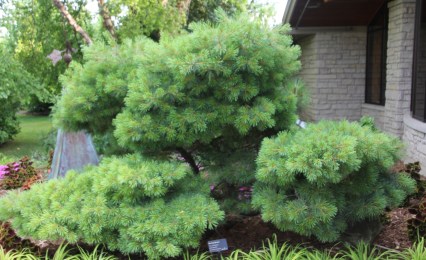I just returned from another great “Addicted Confer Syndrome” conference. In reality, ACS stands for the American Conifer Society. The meeting I attended was the Central Region chapter of the ACS held in Green Bay, Wisconsin. You might be thinking that only white spruce and tamarack are the only conifers that can be grown this far north, but you would be wrong. There are many outstanding conifers that can grow up here and throughout the U.S. Not all conifers are evergreen as there are deciduous conifers, like larch and baldcypress, but most dwarf conifers are evergreen.

According to the American Conifer Society (www.conifersociety.org/conifers/conifer-sizes), dwarf conifers are those that grow between 1-6” per year with an approximate size after 10 years between 1-6’. In contrast, large evergreens grow over a foot a year and are 15’ tall or more after 10 years. Size can vary due to climatic, environmental and cultural conditions. These smaller than usual evergreens are a fraction of the size of their species and fit nicely into the landscape often requiring very little pruning or shaping. Dwarf conifers can provide food and shelter for birds and other small mammals as well as year round interest due to their bright colors and interesting form and texture. An otherwise bleak, winter landscape can be accented with dwarf conifers that come in a variety of colors besides green such as blue, blue-green, silvery-blue, yellow, and purplish.
Below are a few of my favorite dwarf conifers that are available at many garden centers and nurseries.


‘Silberlocke’ Korean fir (Abies koreana ‘Silberlocke’, a.k.a. ‘Horstmann’s Silberlocke’) is a unique dwarf conifer that looks spectacular all year round. The soft needles are different than most conifers as they curve upwards, revealing the bright, silvery-white, frosty undersides. The silvery-gray twigs also add to the plant’s interest. ‘Silberlocke’ Korean fir grows slowly up to 5-7’ in height with a 4-5’ spread eventually growing into a small, compact, conical tree. Firs, in general, require a sandy-loam, moist, well-drained soil and are intolerant to heavy, poorly-drained, clay soils. This cultivar prefers morning sun, but some afternoon shade. ‘Silberlocke’ Korean fir is hardy to zone 4b.

‘Blue Shag’ eastern white pine (Pinus strobus ‘Blue Shag’) is a dwarf conifer shrub with a compact, rounded form that reaches 3-6’ tall with a 6’ spread. The bluish-green, finely textured needles are very soft and pliable. ‘Blue Shag’ has a slow growth rate and a dense, mounded form making it a great choice for use as a foundation plant instead of the all-too-common yews (Taxus spp.). Like all cultivars of eastern white pine, it grows best in a sandy-loam, slightly acidic to neutral soil. It is sensitive to drought, heavy-clay, poorly drained soil, and road salt. ‘Blue Shag’ eastern white pine is hardy to zone 3a.


‘Bergman’ Japanese white pine (Pinus parviflora ‘Bergman’) is an outstanding, dwarf conifer that forms a dense, compact, wide, rounded to upright shrub. ‘Bergman’ Japanese white pine is a slow grower eventually forming a 4-6’ tall with a 6’+ spread shrub. The blue-green needles are soft, long and twisted. In spring, the immature cones are bright carmine-red contrasting dramatically with the blue-green needles. It is hardy to zone 5a and is adaptable to most, well-drained soils and pH. Unlike many other five-needled pines, Japanese white pine is road salt tolerant.

‘Gold Drop’ eastern arborvitae (Thuja occidentalis ‘Gold Drop’) adds bright color to the landscape. This dwarf conifer shrub grows 4-5’ tall and 3-4’ wide and is shaped like a teardrop; narrow at the top, wider at the base. The soft, aromatic foliage is bright golden yellow when grown in full sun turning a deeper yellow during winter. ‘Gold Drop’ arborvitae is hardy to zone 3b and is adaptable to most soils and pH, but grows best in moist, well-drained, loamy soil. If grown in shade, the golden colored foliage will turn green.
Even though dwarf conifers are often more expensive than other deciduous shrubs, they are well worth it. They have a slow growth rate, require little maintenance and provide year-round color and texture in the landscape.
Laura Jull
Is the Silberlocke Korean fir susceptible to winter burn like the dwarf Alberta spruce?
I am not sure to what extent it is susceptible to winter burn, but nothing compares to dwarf Alberta spruce. I did see slight winter burn on my concolor fir in the yard, but I have the species, Abies koreana which showed no winter burn. I do not have ‘Silberlocke’ in my yard, yet….